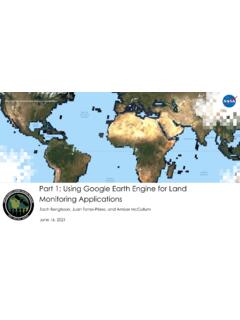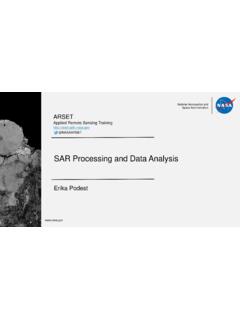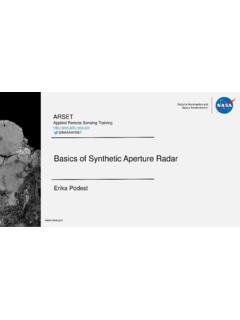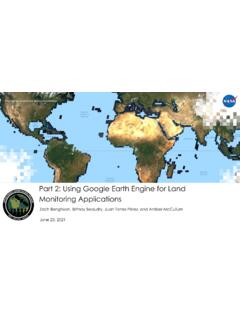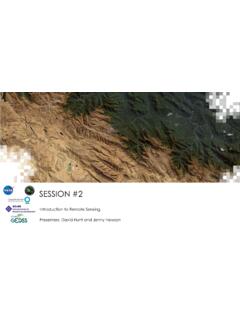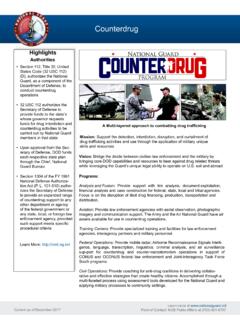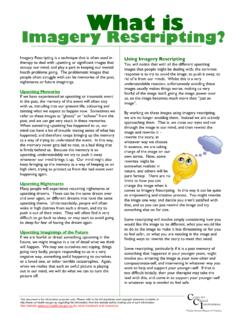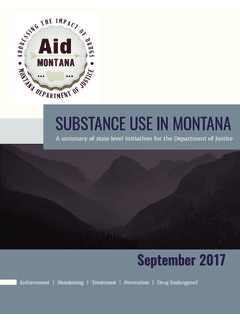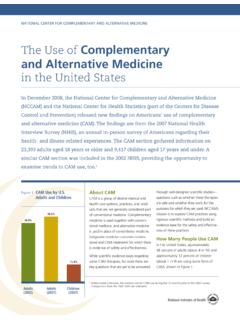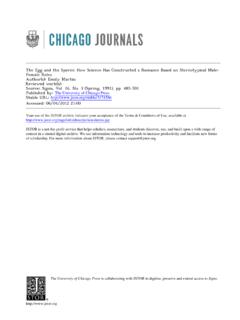Transcription of Fundamentals of Satellite Remote Sensing - NASA
1 National Aeronautics and Space AdministrationPawan Gupta, and Melanie Follette-CookSatellite Remote Sensing of Dust, Fires, Smoke, and Air Quality, July 10-12, 2018 Fundamentals of Satellite Remote SensingNASA s Applied Remote Sensing Training Program2 ObjectivesBy the end of this presentation, you will be able to: outline what the electromagnetic spectrum is outline how satellites detect radiation name the different types of Satellite resolutionsNASA s Applied Remote Sensing Training Program3 What is Remote Sensing ? Collecting information about an object without being in direct physical contact with itNASA s Applied Remote Sensing Training Program4 What is Remote Sensing ?
2 Collecting information about an object without being in direct physical contact with itNASA s Applied Remote Sensing Training Program5 Remote Sensing : Platforms The platform depends on the end application What information do you want? How much detail do you need? What type of detail? How frequently do you need this data? s Applied Remote Sensing Training Program6 Remote Sensing of Our PlanetNASA s Applied Remote Sensing Training Program7 Electromagnetic Radiation Earth-Ocean-Land-Atmosphere System Reflects solar radiation back into space Emits infrared and microwave radiation into spacevisible~ ~ s Applied Remote Sensing Training Program8 What do satellites measure ?
3 Treeswatergrassbare soilpavementbuilt up areaatmosphereNASA s Applied Remote Sensing Training Program9 Measuring Properties of the Earth-Atmosphere System from Space The intensity of reflected and emitted radiation to space is influenced by the surface and atmospheric conditions Satellite measurements contain information about the surface and atmospheric conditionsincom ing solar radiationoutgoing radiationemission by clouds andaerosolsabsorbed by surfacereflected by clouds and aerosolsreflected by surfaceabsorption & emission by atmospheric gasesTrace gas absorptioninfrared radiation emitted by surfaceabsorbed by clouds and aerosolsNASA s Applied Remote Sensing Training Program10 The Remote Sensing ProcessA Priori Information & Radiative Transfer TheoryRetrieval AlgorithmGeophysical ParametersApplicationsSatellite Measured Spectral RadianceSatellites, Sensors, and OrbitsNASA s Applied Remote Sensing Training Program12 Satellites vs.
4 SensorsEarth-observing Satellite Remote Sensing instruments are named according to: Satellite (platform) instrument (sensor)Aqua SatelliteNASA s Applied Remote Sensing Training Program13 Characterizing Satellites and Sensors Orbits Polar vs. Geostationary Energy Sources Passive vs. Active Solar and Terrestrial Spectra Visible, UV, IR, Measurement Techniques Scanning, Non-Scanning, Imager, Resolution (Spatial, Temporal, Spectral, Radiometric) Low vs. High Applications Weather, Land Mapping, Atmospheric Physics, Atmospheric Chemistry, Air Quality, Radiation s Applied Remote Sensing Training Program14 Common Orbit TypesGeostationary Orbit Has the same rotational period as Earth Appears fixed above Earth Orbits ~36,000 km above the equatorPolar Orbit Fixed, circular orbit above Earth Sun synchronous orbit ~600-1.
5 000 km above Earth with orbital passes are at about the same local solar time each dayNASA s Applied Remote Sensing Training Program15 Aqua Satellite Orbiting the EarthNASA s Applied Remote Sensing Training Program16 Observation FrequencyPolar Orbiting Satellites: 1-3 observations per day, per sensorGeostationary Satellites: Every 30 sec. to 15 min. Future Geo satellites: TEMPO, GEMS, Sentinel-4 TerraAquaPolar observationsSource: P. GuptaNASA s Applied Remote Sensing Training Program17 Satellite Coverage Swath WidthVIIRS, 3,000 kmMODIS, 2,300 kmMISR, 380 kmCalipso(SpaceborneLIDAR), ~100 mNASA s Applied Remote Sensing Training Program18 Satellite CoverageMODISVIIRSMISRCALIPSONASA s Applied Remote Sensing Training Program19 Active & Passive Sensors Detect only what is emitted from the landscape, or reflected from another source ( , light reflected from the sun) Examples: (MODIS, MISR, OMI, VIIRS) Instruments emit their own signal and the sensor measures what is reflected back ( sonar and radar) Example.
6 CALIPSOP assive SensorsActive SensorsNASA s Applied Remote Sensing Training Program20 Active & Passive SensorsResolutionNASA s Applied Remote Sensing Training Program22 Remote Sensing Types of Resolution Spatial Resolution Smallest spatial measurement Temporal Resolution Frequency of measurement Spectral Resolution Number of independent channels Radiometric Resolution Sensitivity of the detectorsEach resolution depends on the Satellite orbit configuration and sensor are different for different s Applied Remote Sensing Training Program23 Pixel the Smallest Unit of an Image A digital image is composed of a two-dimensional array of individual picture elements called pixels arranged in columns in rows Each pixel represents an area on the Earth s surface A pixel has an intensity value and a location address in the 2D image Spatial resolution is defined by the size of a pixel*Text Source: Center for Remote Imaging, Sensing & ProcessingcolumnrowNASA s Applied Remote Sensing Training Program24 Why is spatial resolution important?
7 MODIS 250 m 1 km MISR 275 m km OMI 13x24 km VIIRS 375 mSource: Introductory Digital Image Processing, 3rdedition, Jensen, 2004 NASA s Applied Remote Sensing Training Program25 Spectral Resolution Spectral resolution describes a sensor s ability to define fine wavelength intervals The finer the spectral resolution, the narrower the wavelength range for a particular channel or band Multispectral Sensors MODIS moderate spectral resolution Hyperspectral Sensors OMI, AIRS High spectral resolutionBlue+ Green+ mBlack & White Film(Low spectral resolution) Film(High Spectral Resolution)
8 NASA s Applied Remote Sensing Training Program26 Why is spectral resolution important?Adapted from image from: Indian Institute of SciencePercent ReflectanceWavelength ( m)PinewoodsGrasslandsRed Sand PitSilty s Applied Remote Sensing Training Program27 Radiometric Resolution imagery data are represented by positive digital numbers that vary from 0 to (one less than) a selected power of 2 The maximum number of brightness levels available depends on the number of bits (represents radiometric resolution) used in representing the energy recorded The larger this number, the higher the radiometric resolutionImage Source: FIS.
9 *Text Source: Natural Resources CanadaGray ValuesBitsValuesNASA s Applied Remote Sensing Training Program28 Radiometric Resolution Detects the difference in brightness levels The more sensitive the sensor -the higher the radiometric resolution If radiometric precision is high, an image will be sharp Expressed in bits NASA Satellite Sensor Examples: 12 bit sensor (MODIS, MISR, Landsat-9 TM/MSS): 212or 4,096 levels 10 bit sensor (AVHRR): 210 or 1,024 levels 8 bit sensor (Landsat-7 TM): 28 or 256 levels (0-255) 6 bit sensor (Landsat-7 MSS): 26 or 64 levels (0-63) NASA s Applied Remote Sensing Training Program292 -levels4 -levels8 -levels16 -levelsIn classifying a scene, different classes are more precisely identified if radiometric resolution is highMODIS has 4.
10 096 levelsRadiometric ResolutionNASA s Applied Remote Sensing Training Program30 Temporal Resolution How frequently a Satellite can provide observation of the same area on the earth It mostly depends on the swath width of the Satellite the larger the swath the higher the temporal resolutionSwath widthGlobal coverage MODIS 1-2 days OMI 1 day MISR 6-8 days VIIRS 1 day Geostationary 30 sec 1 hrNASA s Applied Remote Sensing Training Program31 Remote Sensing TradeoffIt is very difficult to obtain extremely high spectral, spatial, temporal, ANDradiometric resolutions, all at the same timeNASA s Applied Remote Sensing Training Program32 References and Further Reading Natural Resources Canada: Center for Remote Imaging, Sensing , and Processing: ~research/ NASA Earth Observatory: EOS-Goddard: Spectral Resolution: ~jduh/courses/Archive/geog481w07/
